ZZ Plant Care Guide: Growing A Zamioculcas Zamiifolia
As far as houseplants go, can we ever have too many? I think not. My home is loaded with them, and one of my very favorites is tough as nails, easy to grow, and glossy as a mirror. I want to share these ZZ Plant care tips with you so you can enjoy this gorgeous plant, too.
My ZZ was growing like crazy and had gotten tight in its pot, so I divided it into three plants about a year and a half ago. I gave one away and kept two. Their care requirements are few, and they do well and look good even here in the Tucson desert. The leaves have very few dry tips, and they’re as shiny as can be.
They’re a relatively new introduction to the trade (the late 90s) and weren’t around when I started my horticultural career as an interior plantscaper in the late 70s. I’m sure we would have used this easy-care plant a lot!
Botanical name: Zamioculcas zamiifolia Common name: ZZ Plant, Zanzibar Gem
Note: This post was published on 10/29/2018. It was updated on 10/23/2023 with more info & new images.
ZZ Plant Traits
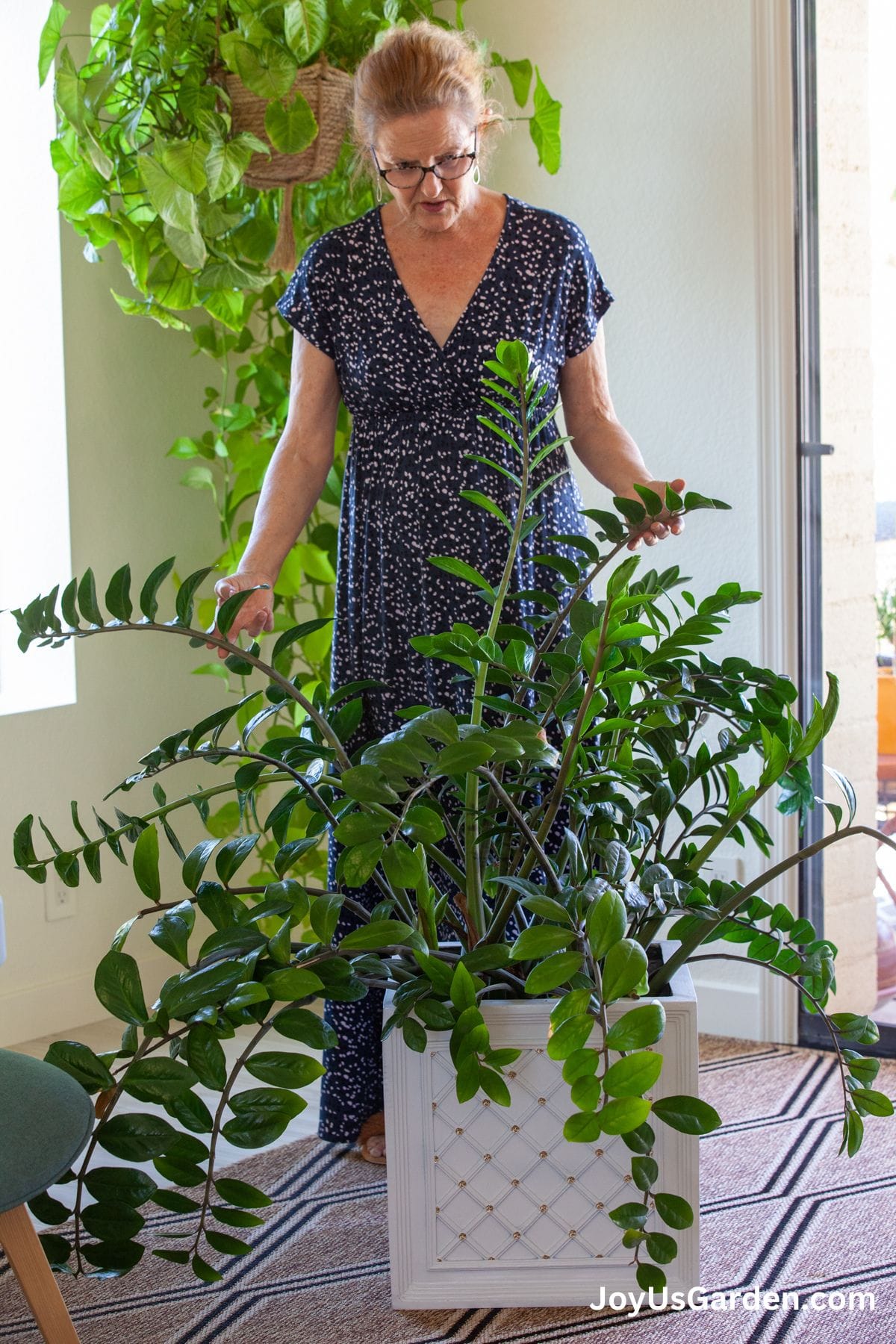
Uses
I’ve seen them used both as tabletop and floor plants. One of mine is directly planted into a decorative pot and sits on a plant stand. The larger one (pictured above) is a floor plant.
I’ve also seen them in large dish gardens. It’s a great plant if you frequently travel or want a good-looking, no-fuss plant.
Size
The average size a ZZ Plant grows to is 3-4′ x 3-4′. Over time, they can reach 5′. One of mine is 4-1/2′ tall (in a 14″ grow pot) by 5′ wide. The other is 2-1/2′ tall x 4′ wide. My Raven ZZ Plant is 3-1/2′ wide x 4′ tall.
They are commonly sold in 4″ to 14″ grow pots.
Growth Rate
They’re reputed to be slow-growing. They’ll grow slower in low-light conditions and when the temps are cooler. For me, they have a moderate growth rate. But then again, I’m in the warm (almost always) sunny Arizona desert.
Mine didn’t do too much growing this summer, but both are putting out a lot of new growth in October. I’ve noticed that they grow in spurts.
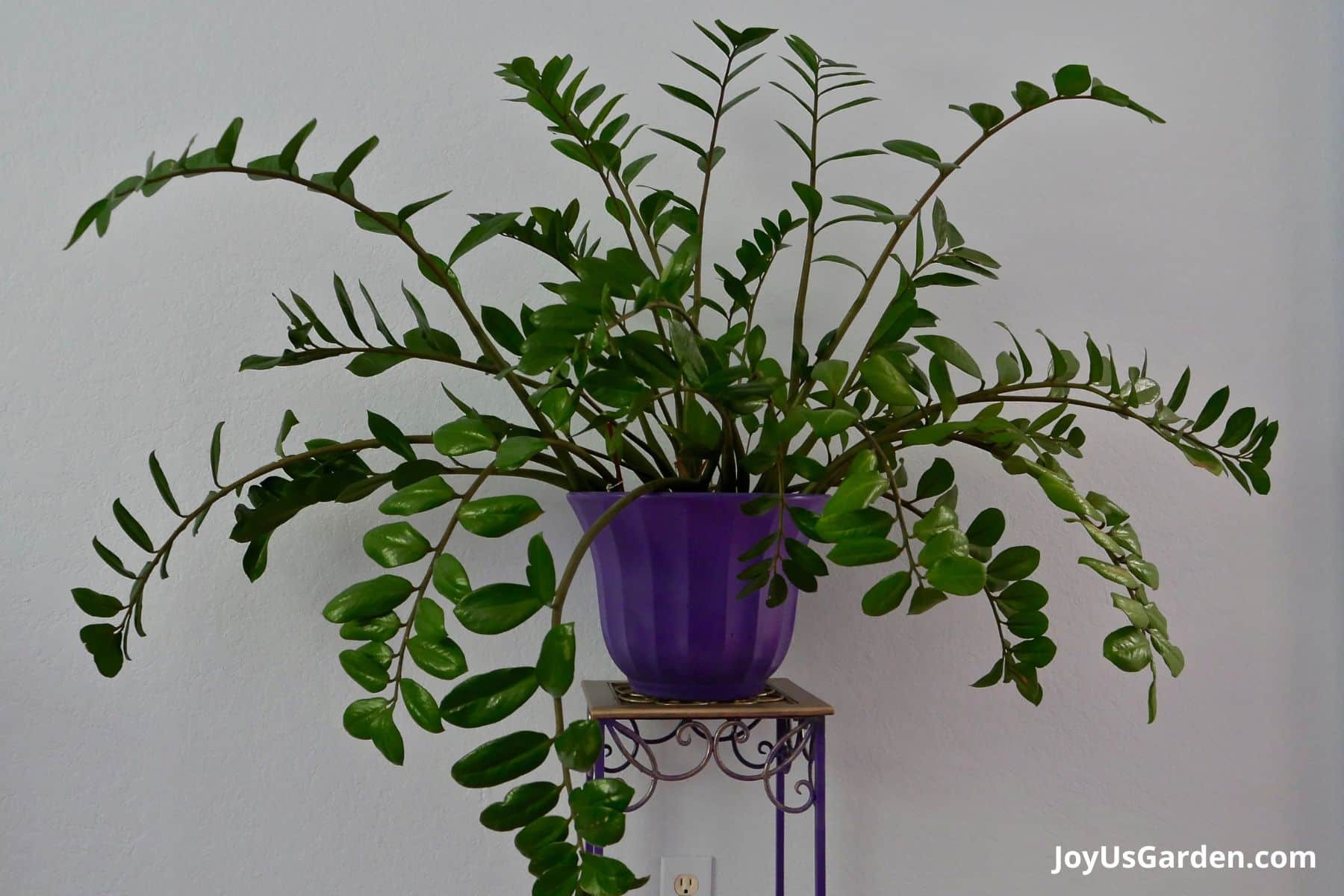
ZZ Plant Care Guide
ZZ Plant Light Requirements
They like bright indirect light. Moderate or medium light is the key for this plant to look its best. They’re often billed as a low light plant but tolerate it; it’s not their ideal.
Low light conditions = little new growth and stretchy stems. In other words, your ZZ Plant will become very leggy, and the leaves will shrink in size.
Conversely, they’ll burn quickly in the hot sun or against a hot window. If you have a room with moderate to high light, keep your ZZ at least 6′ away from any windows with a south or west exposure. Indirect sunlight is the sweet spot.
If needed, rotate yours every couple of months to get the light evenly around. You might have to move your ZZ to a brighter spot in the winter months.
ZZ Plant Watering
It’s good to know that these plants grow from thick, round, tuberous rhizomes. These store water, along with the thick, fleshy roots and somewhat spongy stems.
This is why watering a ZZ Plant too frequently will be its demise. Much like a Snake Plant, too much water too often will kill this plant. This is where well-draining soil comes into play; it allows the excess water to flow out, preventing root rot.
I thoroughly water my ZZs every 2-3 weeks in summer and every 3-4 weeks in winter. I always tell you how often I water my specific houseplants so you have a guideline and can adjust the frequency to your conditions.
Yours might need watering less or more often. Many variables come into play, like the pot size, the type of soil it’s planted in, its growing location, and your home’s environment. The more light and warmth, the more often yours will need watering.
This plant can go for longer periods without water in the cooler, darker winter months.
Here’s a Guide to Watering Indoor Plants. This will help you in determining factors as to how often you water yours.
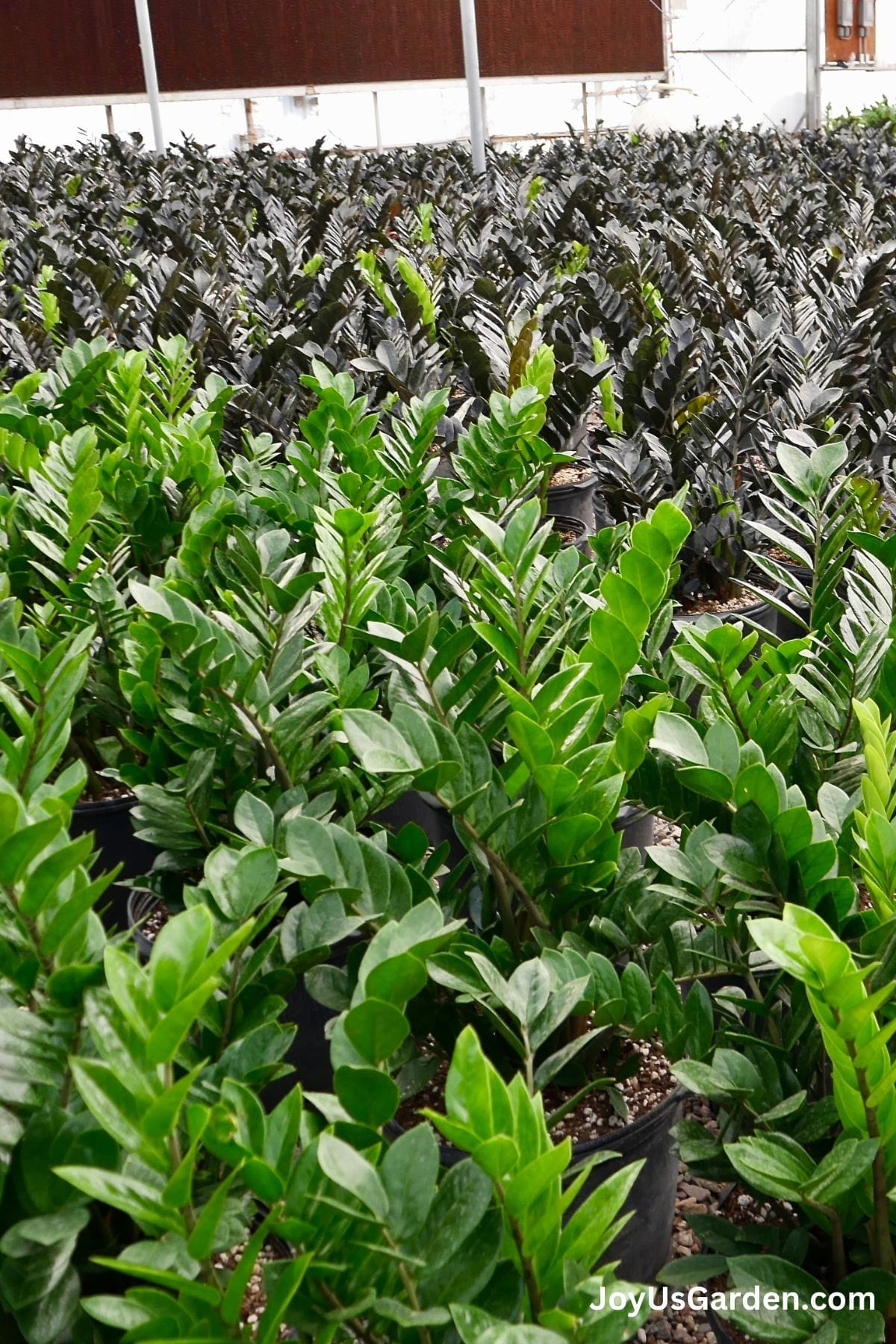
The Plant Stand.
Temperature
If your home is comfortable, it’ll be so for your houseplants, too. Average room temperatures are fine. Keep your ZZ Plants away from cold drafts and air conditioning or heating vents.
Humidity
ZZ Plants are native to tropical regions. Despite this, they’re adaptable and do just fine in our homes, which tend to have dry air and low humidity.
Mine only have a few teeny, tiny brown tips here in hot, dry Tucson. They would prefer more humidity but handle low humidity like champs.
I mist the leaves now and then. I like this mister because it’s small, easy to hold, and puts out a nice amount of spray. I’ve had it for over four years, and it’s still going strong. I also put my plants out in the rain two or three times a year for extra moisture and to clean the foliage off.
I have this humidity meter in my dining room. It’s inexpensive but does the trick and still works fine after a few years. I run my Canopy humidifiers when the humidity reads low, often in the Arizona desert!
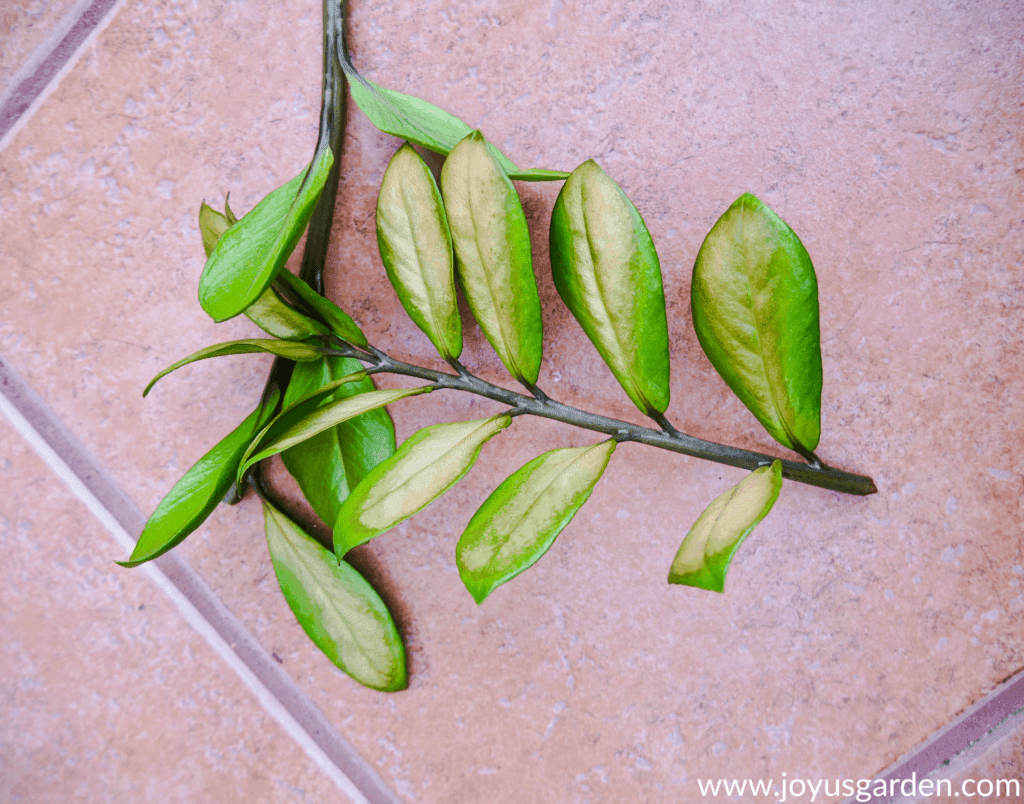
ZZ Plant Fertilizer/Feeding
During the growing season is the best time to feed your ZZ. That’s spring and summer; fall is fine in a temperate climate. ZZ Plants aren’t fussy regarding fertilizing, but they will appreciate it.
We have a long growing season here in Tucson from mid-February through October. I fertilize with Maxsea or Sea Grow, Grow Big, and Liquid Kelp seven times during the growing season. It’s how I feed all my tropical plants. I alternate using these granular and liquid fertilizers and don’t mix them.
Whatever indoor plant food you choose, don’t over-fertilize your ZZ because salts build up and can burn the plant’s roots. This will show up as brown spots on the leaves.
You want to avoid fertilizing any stressed houseplant, i.e., bone dry or soaking wet. I don’t fertilize houseplants in late fall or winter because it’s not their active growing season.
Soil
The mix you use should have good drainage and be well aerated. You don’t want it to stay wet for prolonged periods because this plant likes to dry out between waterings.
When I divided my ZZ, I used a blend of 3/4 potting soil (formulated for indoor plants) and 1/4 cactus and succulent mix with a few handfuls of compost and worm compost thrown in for richness.
I use this DIY Cactus and Succulent Mix with coco chips, coir, and pumice. The potting soils I use are this one and this one. Sometimes, I use them solely, and sometimes, I blend them.
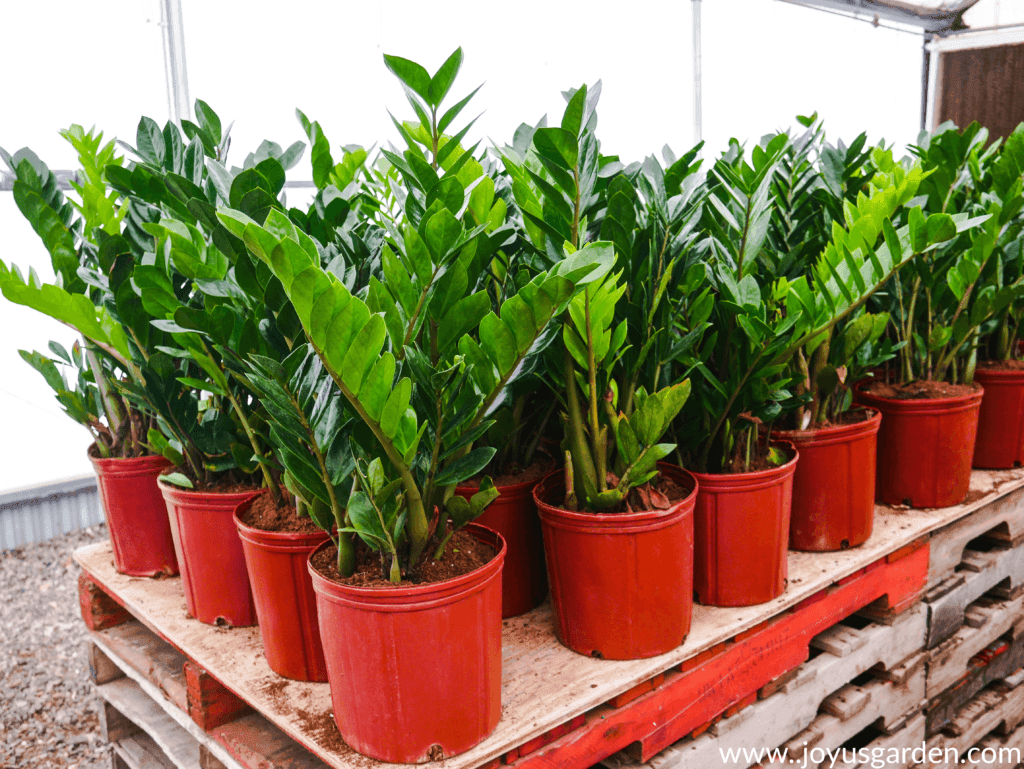
Repotting ZZ Plants
This is best done in spring or summer; early fall is fine in a warm climate. The faster your plant is growing, the sooner it’ll need repotting.
ZZ Plants prefer to grow slightly tight in their pots. That being said, a ZZ Plant can’t stay in a small pot for years. The root system and thick rhizomes are vigorous, so a bigger pot will eventually be in order. I repot mine every five to seven years.
Depending on the size of the plant and the rootball, going up one pot size may be fine. I repotted mine growing in a 10″ pot into a 14″ pot because the root ball needed it.
All three of mine are growing in plastic pots, but terra cotta or ceramic work, too. Whatever pot you use, make sure it has at least one drainage hole so the excess water can flow out, preventing root rot.
Pruning
Not much is needed. The main reasons to prune this plant are for propagation or to prune off the occasional lower yellow leaf or bending, arching stem.
New growth will eventually appear if you need to prune your ZZ Plant. Just make sure your pruners are clean and sharp before you do any pruning.
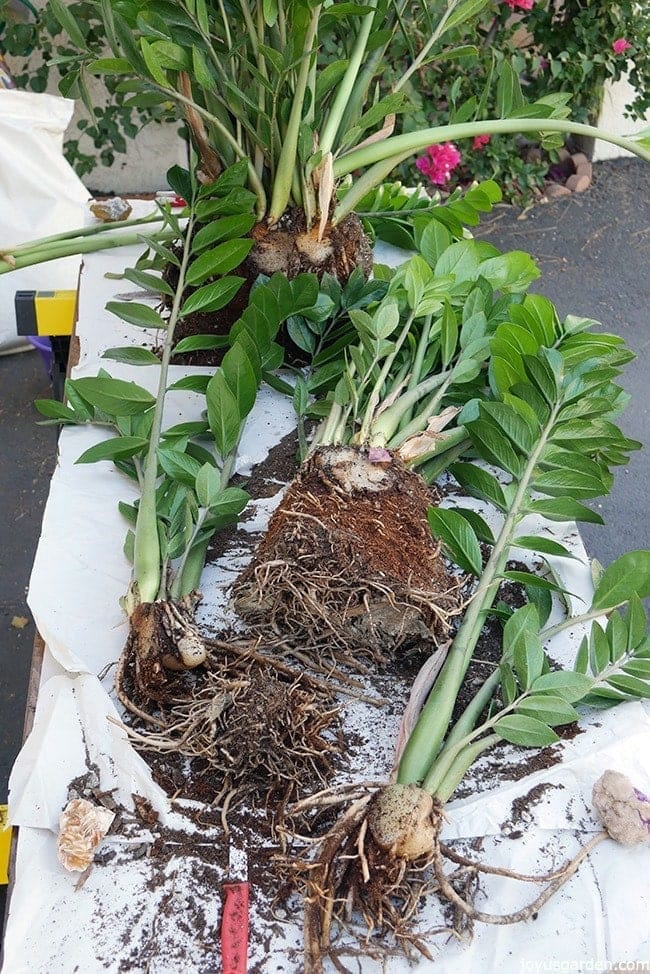
Propagating A ZZ Plant
I’ve propagated a ZZ Plant successfully by division and also rooting stems in water. These posts will explain everything to you.
They propagate via seed and leaf cuttings in water, but I’m way too impatient for either of those methods.
Rooting stem cuttings in water is successful, but it’s a seven to ten-month process. With division, you get instant plants!
Pests
Mine have never gotten any. I’ve heard they can be subject to mealybugs, aphids, scale, and spider mites. It’s best to take action as soon as you see any pest because they multiply like crazy.
For most pest infestations, you can control them with neem oil or insecticidal soap. The latter is what I’ve been using for two years now and has been effective.
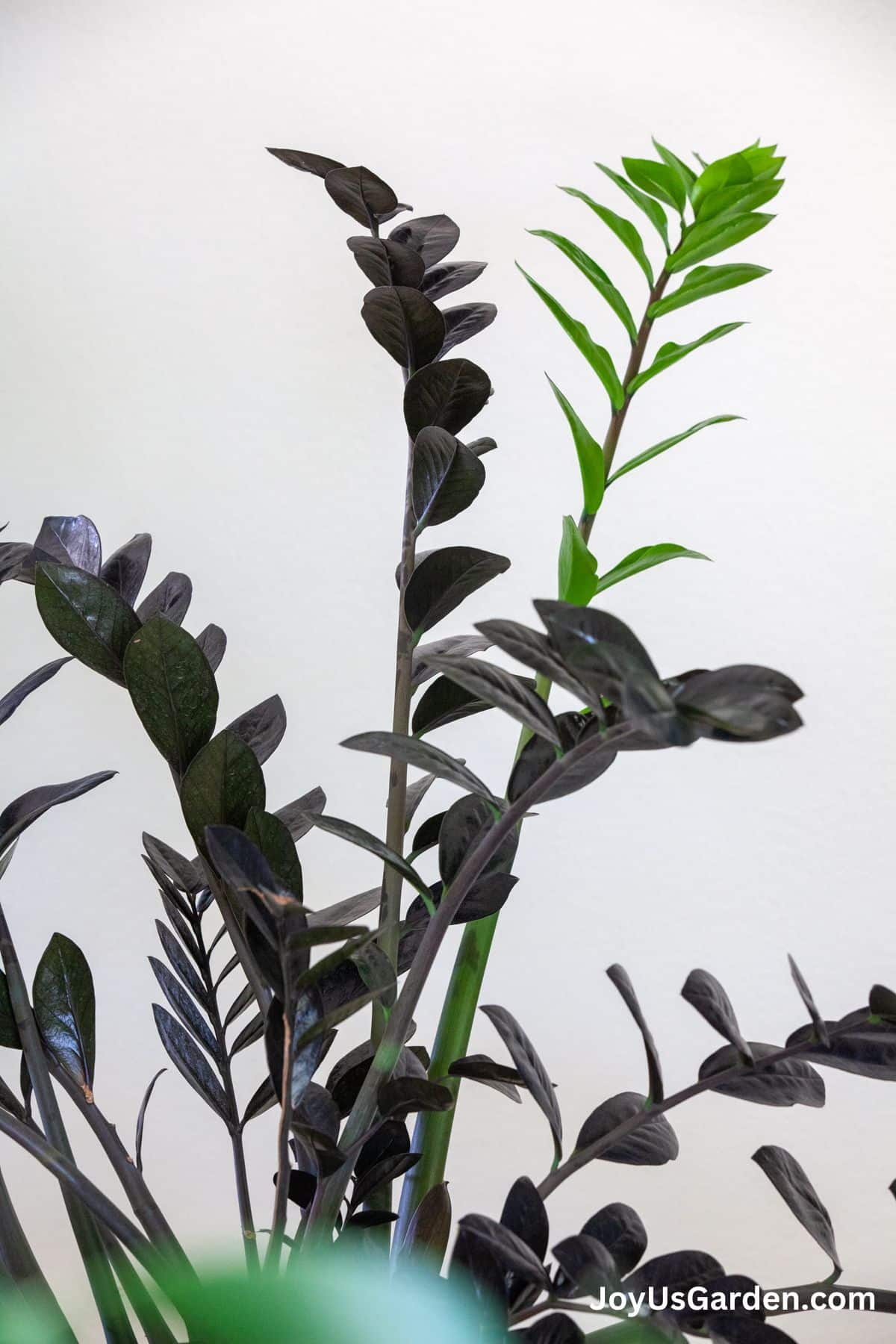
Toxic To Cats & Dogs
All parts of this plant are reported to be toxic, but how harmful is up for debate. I refer to the ASPCA site for information on this subject, but it doesn’t list this plant. I have two kitties, and they pay no mind to my ZZs.
Most houseplants are toxic to pets in some way. If your cat or dog likes to chew on plants – keep it away from them to be safe. Here’s a list of pet-friendly, easy houseplants for your reference.
Cleaning
Houseplants don’t like a build-up of dirt or dust. I put mine out in the rain a couple of times a year. If you can’t put it outdoors, your ZZ would appreciate a gentle hosing off in the shower or sink. You can also use a damp cloth to wipe off the shiny leaves.
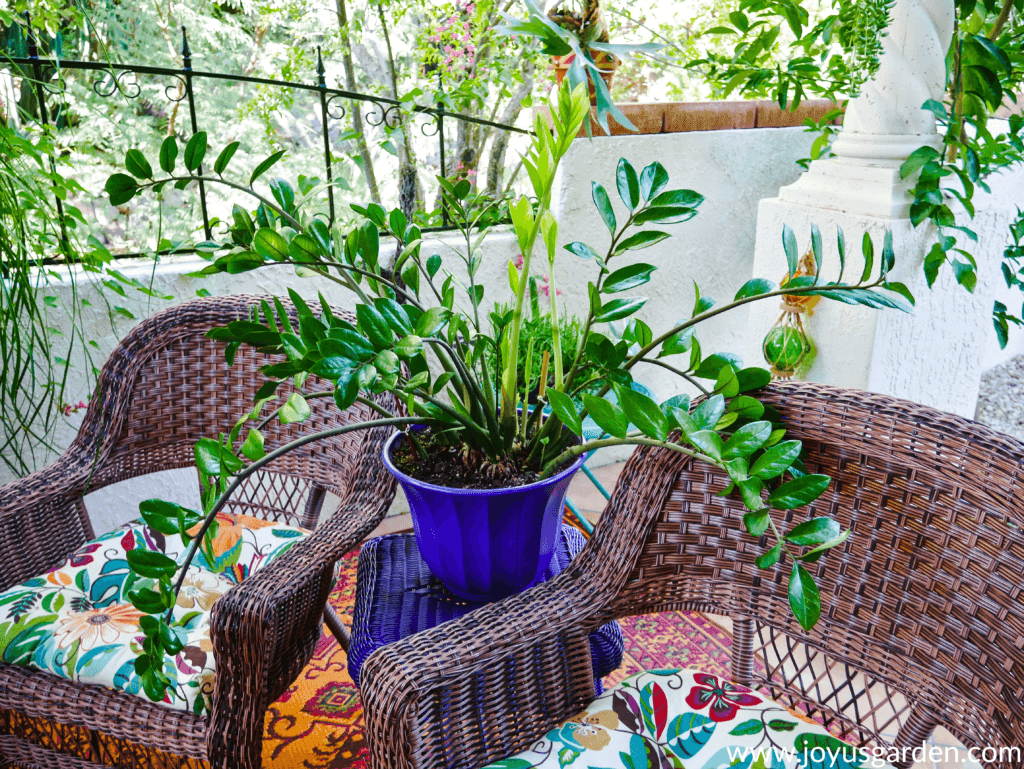
Common Problems With ZZ Plants
(Note: some of these aren’t problems; they’re things good to know).
It’s billed as a low-light plant but looks much better in moderate or medium-light conditions.
The leaves are naturally shiny. They look even better, and the plant functions better when clean. Please don’t use commercial leaf shine. It clogs the pores, and the leaves have trouble breathing. Besides, you don’t need it with this plant!
When you buy a ZZ Plant, it’s tight and upright. With age, it spreads and fans out. My largest ZZ is 4-1/2′ tall by 5′ wide.
Leaves that get too spready or droopy can be cut off and propagated in water. Rooting is a slow process, so be patient.
Speaking of propagation, I divided my ZZ about six years ago. The root ball is thick and tough, but it can be done.
This plant burns in direct sunlight. Keep it out of any hot windows.
ZZs will succumb to root rot if you water them too often. I let the soil go almost dry before watering again. Back off on the frequency in the winter – it’s not their active growing season.
This plant is toxic to pets and humans. The opinions vary about the degree of toxicity – I can only say that it’s never bothered me when I’ve touched or gotten it on my skin. To be safe, wear gloves. When handling this plant, don’t get your hands near your eyes, mouth, or nose. And of course, don’t eat any!
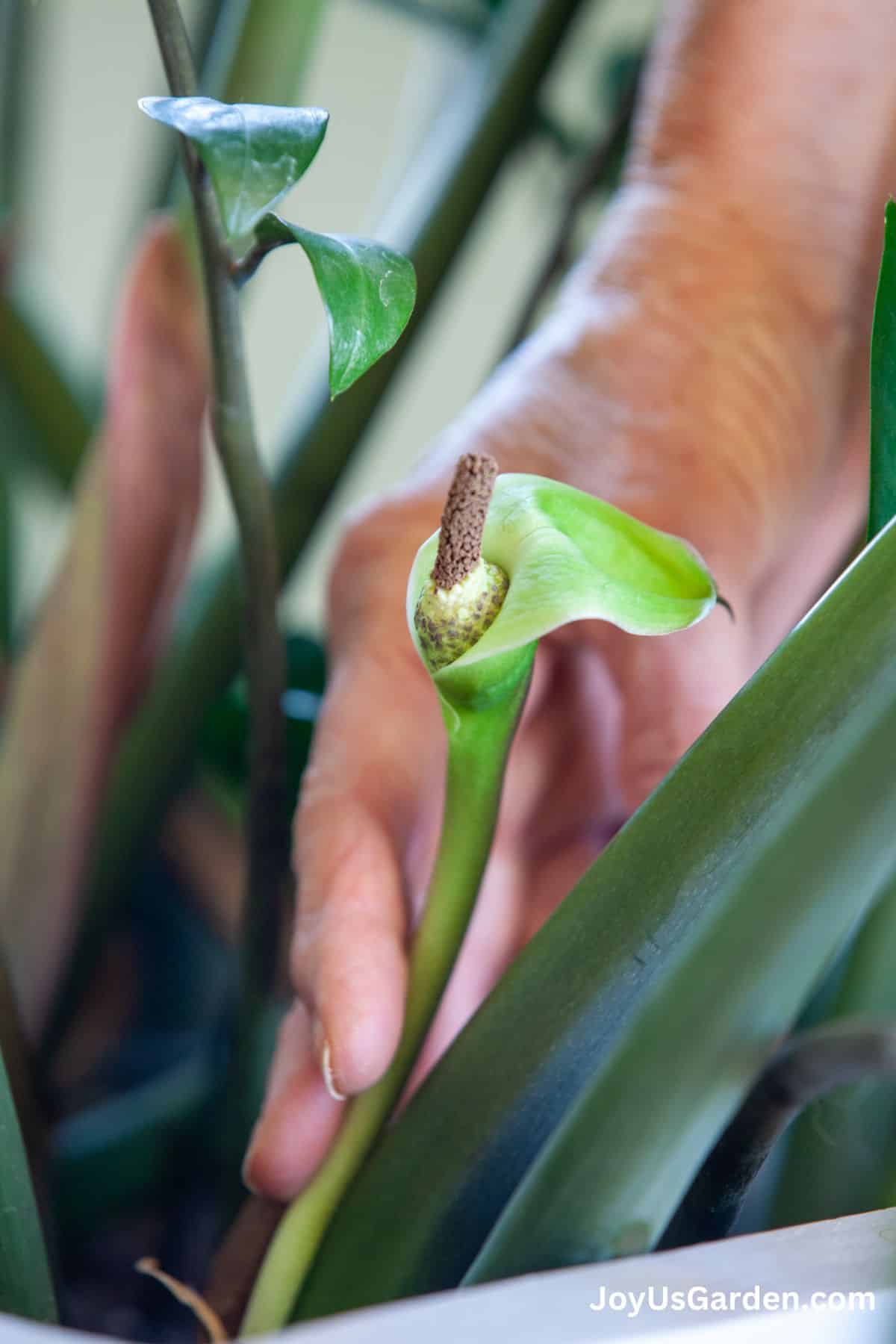
ZZ Plant Flowering
ZZ Plants have a greenish-white flower, which isn’t significant or showy. It’s similar to the flower of a Peace Lily and Anthurium.
It’s not common for them to flower when growing indoors. I’ve had my large one for six years; this is the 2nd time it’s bloomed. The plant bloomed in summer and had four flowers.
ZZ Plant Decor Ideas
ZZ plants can used in any room, as long as it has adequate light. I have one in the kitchen, another in the living room, and a third in the bedroom.
ZZs in smaller pots can grow on a table, shelf, or countertop. Larger plants are suited for the floor as they grow as wide as they grow tall. Two of mine are on the floor, and the other is on a plant stand.
This plant goes with every decor style and adds life to any room with its glossy foliage and striking form. If you’re looking for a dark and dramatic houseplant, check out the Raven ZZ. Its bronze foliage sets it apart and is a real attention-getter!
ZZ Plant Care Video Guide
ZZ Plant Care FAQs
The ZZ truly is a resilient, drought-tolerant plant that requires minimal effort on your part. A healthy ZZ Plant likes adequate light, not to be watered too often, and to have an occasional shower to keep those gorgeous leaves clean and glossy.
In the summer months, you’ll need to water more often, and in the winter, less often.
Yes, indirect bright light is best, but too much light in the form of direct sun will cause burn. Keep yours out of west and south-facing windows and away from hot glass, especially in the summer.
ZZ Plants aren’t fast growers. If yours isn’t growing, it’s probably not getting enough light. Other reasons could be improper watering or lack of nutrients.
A few yellow leaves on a plant are normal; however, if it seems significant, the most common cause is likely too much water. ZZ Plants don’t like to sit in consistently wet soil. Other reasons for yellow leaves could be a nutrient deficiency, pest infestation, too heavy soil, the light levels needing adjusting, temperature stress, and insufficient water.
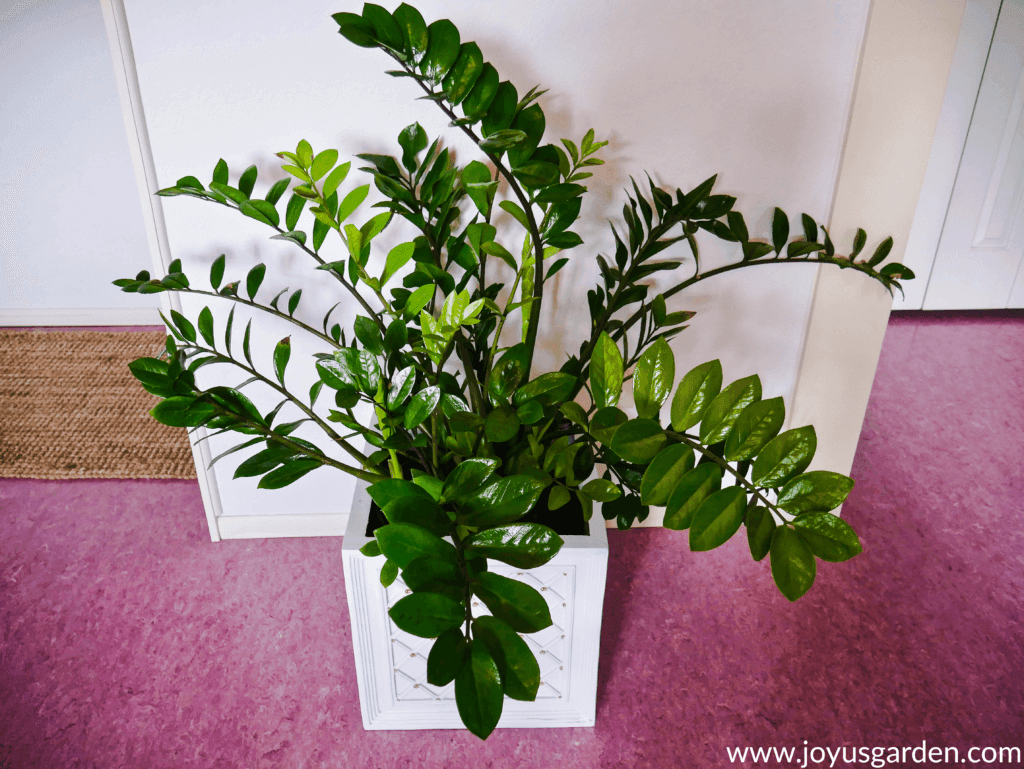
In Conclusion, caring for a ZZ Plant is straightforward. Follow these simple guidelines, and you’ll have a thriving ZZ plant that adds life to your space. To do its best, this low-maintenance houseplant needs bright indirect light, watered when dry, fed a few times during the growing season, and cleaned off once or twice a year to keep the foliage shiny and looking good.
I love my ZZ Plants, and so do others who see them. They get the comment: “What is that plant?”. It’s music to my eyes when they put out that glossy green, fresh new growth. Why not give the ZZ Plant a try? If you can’t find one where you live, here’s an online option.
Happy gardening,

This post may contain affiliate links, you can read our policies here.
- About the Author
- Latest Posts
Nell, the founder of Joy Us garden, was born into a gardening family and grew up in Connecticut’s countryside. After living in Boston, New York, San Francisco, & Santa Barbara, she now calls the Arizona desert home. She studied horticulture & garden design, working in the field all her life. Nell is a gardener, designer, blogger, Youtube creator, & author. She’s been gardening for a very long time & wants to share what she’s learned with you.



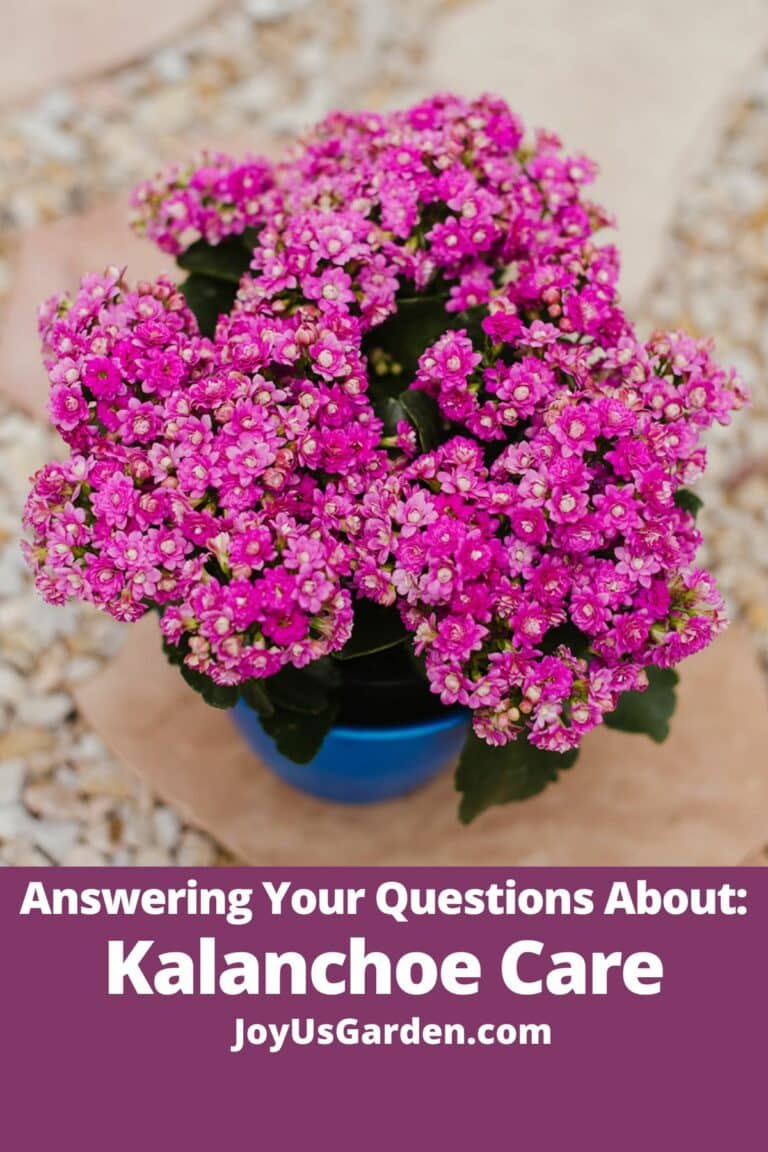
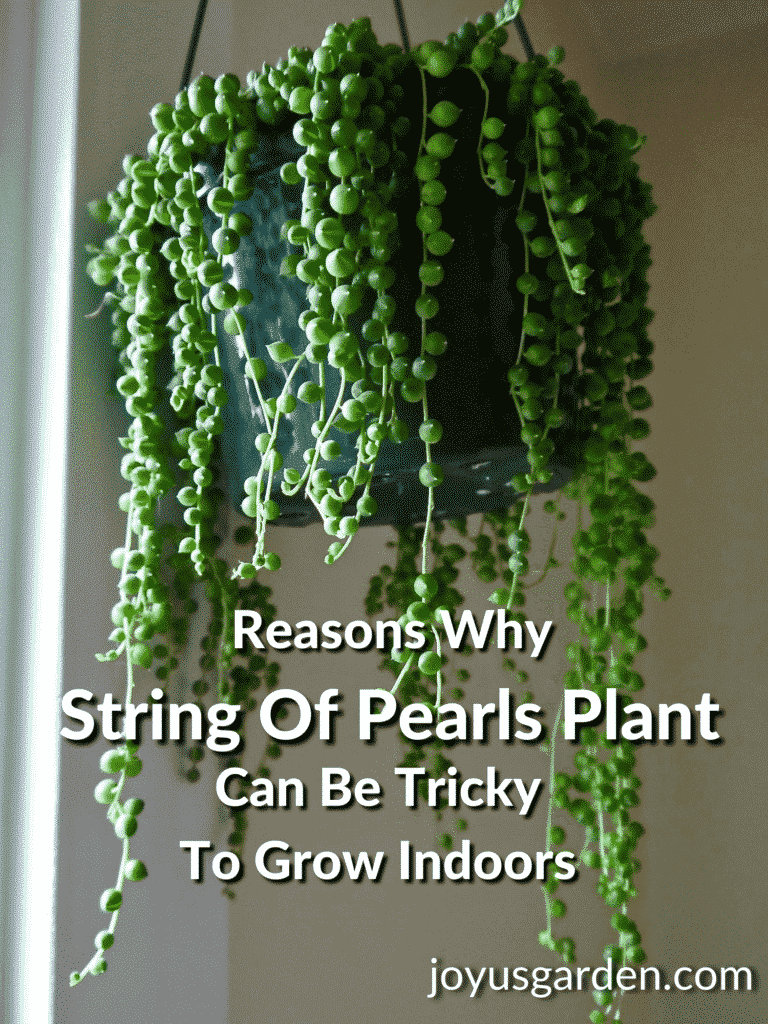
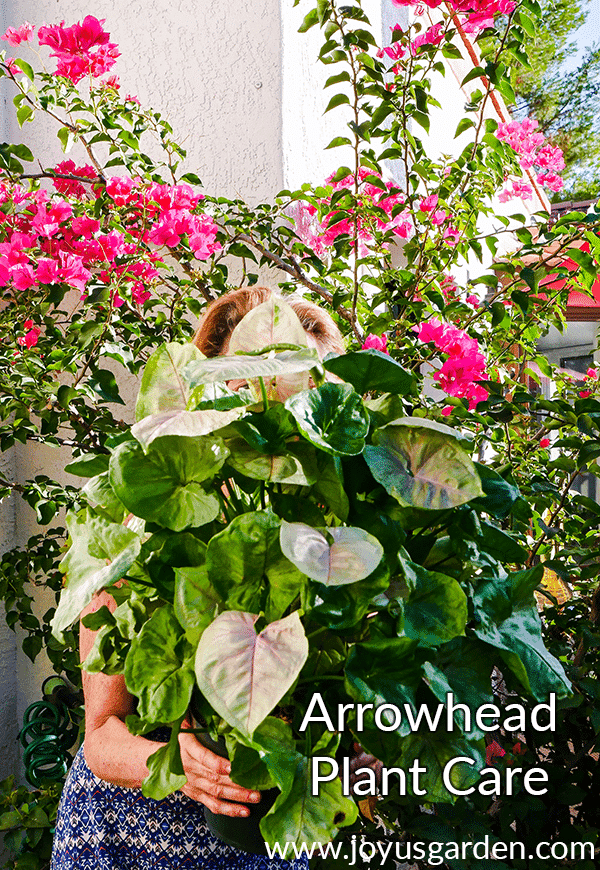
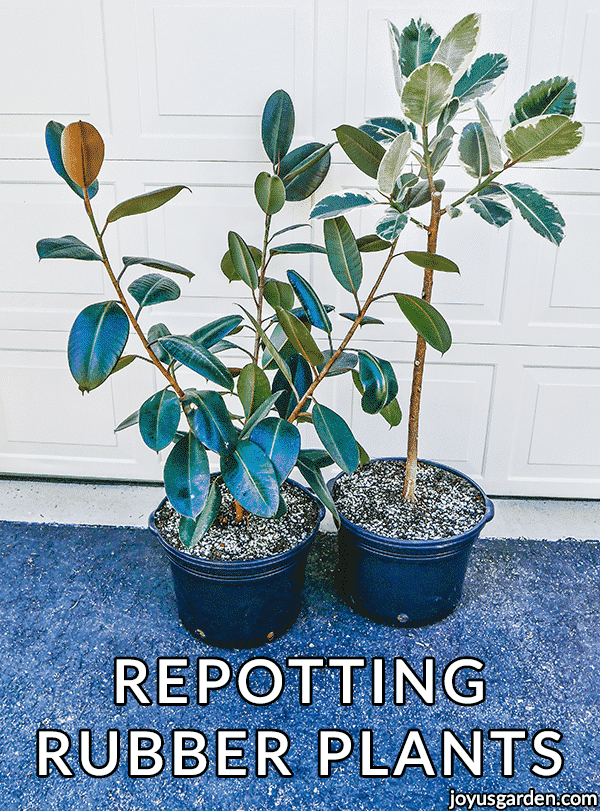

Hi.
Greetings from United Arab Emirates 🙂
I would like to say that yours is the best work available online on gardening. Keep it up and stay lush and happy ?
Something is bothering me regarding the new growth of my ZZ plant. The new shots are of considerably smaller stature as compared to the ones in pot.
I have very healthy beautiful ZZ plant. It is very old around 4 years or so.
Please advice what could be the reason for new growth to make smaller branches and not big and tall like the older ones in pot.
Best regards
Sarah
Hi Sarah – Greetings from the Arizona desert. As my 2 ZZs have gotten bigger, the new growth tends to come out small.They tolerate low light but do better in moderate light.So, I think the thick new growth overshadows & crowds out some of the new growth. Nell
I loved reading about my ZZ Plant!!!
Timothy – Love my ZZ Plants! Nell
Hi! Is it okay to put my new zz plant on a ceramic pot with no holes? Since I live at the basement with no window. do you think the pot that I bought (with no holes) is ok to use for my zz plant?
Thanks!
Erika – Plants prefer a pot with drainage. ZZ’s don’t need frequent watering, so if you prep the pot properly, it might do fine for a year or 2. Nell
Thank you for providing such an extensive expanation of these wonderful babies! I just repotted my Raven ZZ and was wondering if it would be alright to put river rocks or aquarium gravel on top of the soil. I have a well draining pot and I water sparingly, but I don’t want to hinder any new babies from popping up!
You’re welcome, Heather! The new growth is tender & soft so I’m not sure that would be a good thing. I’ve never done it. You could try it with a thin layer of small rock & see how it goes. Nell